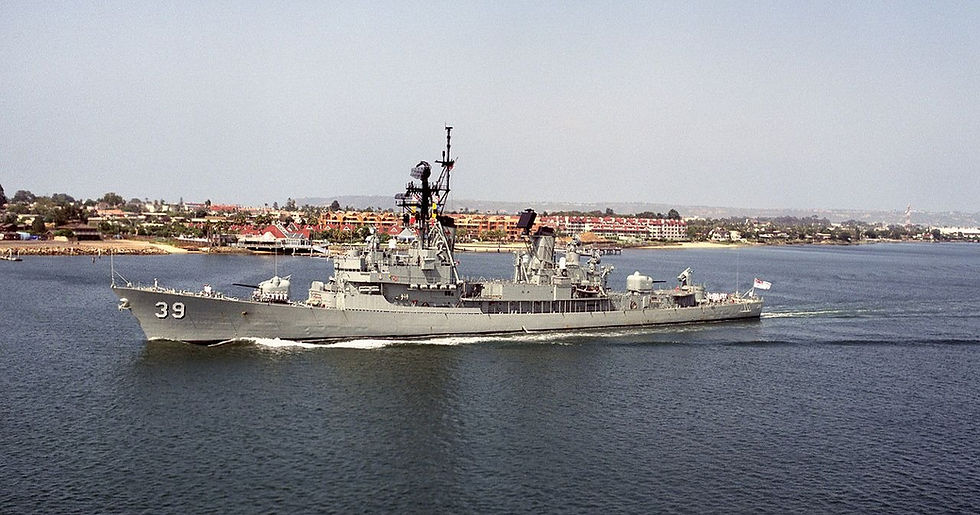HMAS Torrens DE53
- Nepean Naval Museum

- Feb 19, 2023
- 3 min read

HMAS Torrens (DE 53) was a River Class destroyer escort of the Royal Australian Navy (RAN).
Torrens entered service in 1971, and was active until her decommissioning in 1998.
The ship was sunk as a target by HMAS Farncomb in June 1999.
Images and footage of the ship sinking have been used and adapted for various purposes, including in movies and as propaganda.
Construction and General characteristics
Torrens and sister ship HMAS Swan were ordered in 1964 as replacements for HMAS Voyager, following her collision with HMAS Melbourne. Although intended to be the same as the previous River class ships (themselves based on the British Type 12 frigate), the design was changed from 1965 to incorporate many of the improvements of the British Leander class frigates. Work on the two vessels started without specifications or a contract, and the evolving design meant changes were being made as the ships were being constructed, with resulting delays and cost increases attributed to a lack of planning.
Torrens was laid down by the Cockatoo Docks and Engineering Company Propriety Limited at Sydney, New South Wales on 18 August 1965. She was launched on 28 September 1968 by Dame Zara Holt, and commissioned into the RAN on 19 January 1971.[citation needed] Torrens was the last major war vessel built in an Australian shipyard until work commenced on HMAS Melbourne in 1985.

She displaced 2,700 long tons (2,700 t) had a length of 107 m (351 ft), was 12.49 m (41.0 ft) across the beam, and had a draught of 4.57 m (15.0 ft). Her propulsion came from two English Electric steam turbines, producing 30,000 shp (22,400 kW), plus two JTA 500 kW generators from the steam turbines; and two KTA 500 kW generators powered from diesels.
She was capable of 30 knots (56 km/h; 35 mph) and had a range of 4,500 nautical miles (8,300 km; 5,200 mi) at 12 knots (22 km/h; 14 mph).
Her complement: was 250 men.
Her sensors and processing systems included a 1991 Mulloka sonar system Radar, and a 8GR-301 surface-search/navigation radar, which was refitted in 1991 with a Krupp Atlas ARPA 8600, LW-02 Long Range Air Search Radar, an M22 Gun Fire Control System, and an M44, ELT-901 EW System.
Armament: consisted of two 4.5-inch (110 mm) Mark 6 guns, one Limbo anti-submarine mortar, one quad Seacat SAM launcher, one Ikara ASW system, and two Mark 32 torpedo tubes.
Operational history
Torrens and the destroyer tender HMAS Stalwart participated in celebrations of Papua New Guinea's independence from Australia in September 1975, with Torrens arriving in Rabaul on 14 September. On 16 August 1976, Torrens and HMAS Melbourne were performing work-up exercises following the latter's refit when they were called to assist MV Miss Chief off the coast of Bundaberg, Queensland. During late February and early March 1972, Torrens escorted the troopship HMAS Sydney on her twenty-fourth and final troop transport voyage in support of the Vietnam War. The ships arrived in Vũng Tàu on 28 February, collected 457 Australian soldiers, then departed the next day for home.
Decommissioning and fate
HMAS Torrens paid off in 1998. On 14 June 1999, Torrens was sunk by a live Mark 48 Mod 4 torpedo fired by the Collins-class submarine HMAS Farncomb during the latter's combat system trials. Digitally edited film of the torpedo hitting Torrens was used in the 2001 film Pearl Harbor as part of a black-and-white 'newsreel' montage. A photo of Torrens exploding was used on a Hezbollah-operated website to support a propaganda claim that an Israeli warship was sunk by a Hezbollah missile in July 2006.
Her 4.5-inch Mk V/Mk 6 gun turret is preserved at Princess Royal Fortress, Albany, Western Australia.
Members Who Served:
Members of the Nepean Blue Mountains Sub-Section who served on the Torrens.







Comments